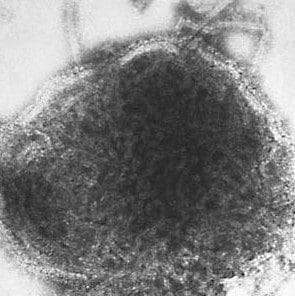
Get A Testing Quote
Simian Vacuolating Virus 40 (SV40)
Virus
Simian Vacuolating Virus 40 (SV40)
Structure
Non-Enveloped
Family
Polyomaviridae
Primary Host(s)
Monkey/Human
Disease(s) Caused
Various cancers including brain and bone tumors, and malignant pleural mesotheliomas in laboratory animals.
Symptoms
Tumorigenesis, potentially leading to malignancy
Potential Complications
Immunosuppressed Individuals
Transmission Mode
Contact with infected body fluids, particularly contaminated blood
Importance of Simian Vacuolating Virus 40
Simian Vacuolating virus 40 was originally introduced into the human population with contaminated poliovirus vaccines in the 1950s and ‘60s. SV40 is an oncogenic virus in many laboratory animals, meaning that, in some cases, it leads to cancer. Inoculating SV40 into small mammals like hamsters and rats have demonstrated that the virus is tumorigenic and can lead to malignancy. In humans, there is new evidence establishing links between SV40 and cancers, especially rare cancers. The virus has been observed to be semi permissive to human cells in vitro: the virus propagates in some cells while others resist the virus. Cells that resist the virus can still coopt the viral genome, which can lead to cell immortalization. Further studies have shown a correlation between SV40 infection and cancer formation in vivo.
Importance of Disinfection
Disinfection of Simian Vacuolating Virus 40 may protect individuals against a potentially oncogenic virus and may give an insight into the product’s performance against other closely related human viruses like BK virus and JC virus, as well as the greater Polyomaviridae family. As a non-enveloped virus, SV40 is difficult to inactivate. Studies comparing the efficacy of a range of disinfectants show that a 0.5% quaternary ammonium solution demonstrated a 1.10 log10 and 1.92 reduction in viral titer at 5 minutes and 60 minutes, respectively, while a 0.05% peracetic acid solution demonstrated 4.26 log10 reduction at 5 minutes. The hardy nature of SV40 will test the full limits of a product’s virucidal efficacy.
References
- Garcea, Robert L, and Michael J Imperiale. “Simian virus 40 infection of humans.” Journal of virology 77,9 (2003): 5039-45. doi:10.1128/jvi.77.9.5039-5045.2003
- Hufbauer, Martin et al. “Inactivation of Polyomavirus SV40 as Surrogate for Human Papillomaviruses by Chemical Disinfectants.” Viruses 13,11 2207. 2 Nov. 2021, doi:10.3390/v13112207
- Image from: E.L. Palmer/Centers for Disease Control and Prevention (CDC)
Share

